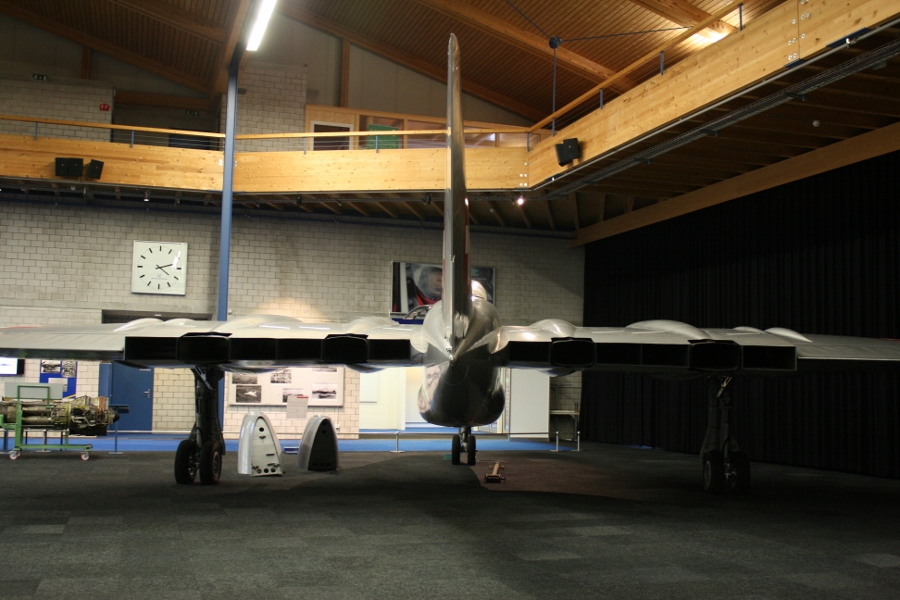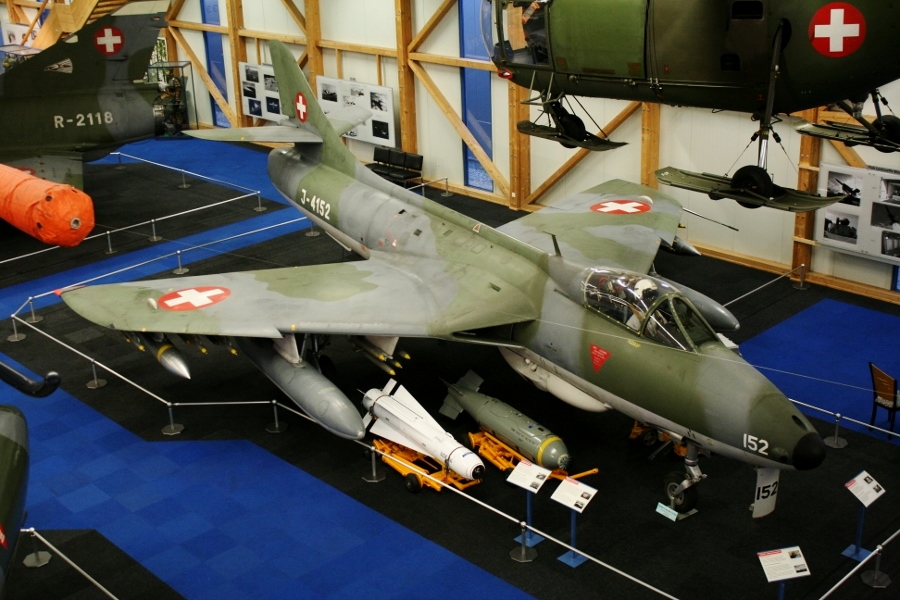In the 1950’s the Swiss worked on the development of two domestically designed and produced jet combat aircraft for the Swiss Air Force, the EFW N-20 Aiguillon (Sting) fighter and the FFA P-16 ground attack fighter. Both projects only reached the prototype stage and ultimately both were cancelled. Luckily examples of both aircraft survive today and are on display in Hall 2 of the Swiss Air Force Centre (Flieger Flab Museum – a wonderful and well-lit treasure trove of a museum) at the Swiss Air Force base in Dübendorf near Zurich which I visited in December 2015 (the FFA P-16 is actually a composite of parts from 2 aircraft).
EFW N-20
Following the testing of a EFW N-20.01 3/5th scale wooden glider (which later crashed) and the smaller scale EFW N-20.02 Arbalète (Crossbow) jet test aircraft powered by four small Turbomeca Piméné turbojet engines (test flown until 1954, it is apparently also part of the museum collection but I did not see it on display during my visit in 2015), the one and only full-scale EFW N-20.10 Aiguillon prototype designed by Eidgenössische Flugzeugwerke Emmen (the Swiss federal aircraft factory) briefly first flew during a taxi test on April 8th, 1952. It was a large, unusual looking, tailless, swept-wing design powered by four Swiss-Mamba SM-01 turbojet engines (interestingly a development of the Armstrong Siddeley Mamba turbo-prop engine with the propeller reduction gear box removed and replaced by a low pressure compressor).








The EFW N-20.10 Aiguillon was the first Swiss home-grown jet fighter design and it was intended to replace the ageing piston engine combat aircraft and early fleet of British designed de Havilland DH.100 Vampire jet fighter-bombers of the Swiss Air Force. Unfortunately not long after that first flight of the EFW N-20.10 though it was realised the SM-01 engines were not powerful enough and a proposed version with two uprated Rolls Royce Avon turbojet engines, the EFW N-20.20 Harpon was wind model tested but both the SM-1 engine and N-20 aircraft projects were cancelled by the Swiss government in 1952 (only 6 SM-01 engines were built).
Development issues, rising costs and immediate availability of other proven aircraft spelt its demise and that was the end of the EFW N-20 concept. For the next 20 years the Swiss soldiered on with flying the de Havilland DH.100 Vampire that had entered service between 1946 and 1951.


FFA P-16
At a stage in 1950’s jet design when none of the western aircraft manufacturers could provide a suitable short take off and landing capability, the FFA P-16 from the Flug und Fahrzeugwerke AG company was designed with good short-field performance and the ability to take off from unprepared airstrips at high altitude which is characteristic of the Swiss alpine countryside. The low, straight, large wing area design was fitted with high-lift devices including leading edge and trailing edge flaps (the leading edge ones could change the wing profile when extended) and it could take off and land within an amazing 500 metres or 1,640 feet! This was much better than its proposed predecessor and ultimate successor (see below).


The first of two FFA P-16 Mk.I prototypes flew on April 25th, 1955 powered by an Armstrong Siddely Sapphire ASSa 6 turbojet engine but crashed after 22 flights (J-3001). The second prototype (J-3002) went on to conduct 310 test flights from 1956 before being scrapped in 1958.

A pre-production FFA P-16 Mk.II variant (J-3003) fitted with a more powerful Armstrong Siddely Sapphire ASSa 7 turbojet engine began test flights in 1958 and showed great promise (in level flight the design could reach a top speed of Mach 0.92 or Mach 1.1 in a shallow dive), so much so the Swiss government placed an order for 100 of them to replace the DH.100 Vampire (ironically the Vampire fighters went on to fly with the Swiss Air Force until 1974!). Then in March 1958 the aircraft crashed and the government cancelled all orders for the aircraft and purchased 100 of the proven Hawker Hunter F.Mk.58 fighter instead (which had entered British service in 1954) and the type went on to serve until 1994. Oh what could have been for the FFA P-16!






FFA decided to soldier on with the P-16 concept and built 2 Mk.III variants from unfinished Mk.II aircraft in 1959 and 1960 respectively (J-3004 and J-3005). They were armed with 2 x Hispano-Suiza 825 30mm cannons and rocket launchers. FFA flew these until 1960 but ultimately the high cost of continuing development for a limited production run, without domestic or overseas sales meant it was no longer worth a small country pursuing the concept. Thus ended the development of home-grown combat jet aircraft in Switzerland.
References:
History of the Swiss Air Force
Popular Mechanics – April 1956
World at War – Swiss Guards: the Federal Aircraft Factory N-20 and the FFA P-16

[…] via Swiss Air Force Centre: Home Grown Jet Fighter Prototypes — Aces Flying High […]
LikeLiked by 1 person
Interesting, did not know about the Swiss aeronautical development in that period, Not widely publicized. Rare information, thanks.
LikeLiked by 1 person
My pleasure! I am glad they preserved their aviation heritage. I wish Australia had been better at it with our home-grown aircraft designs in WW2 and post-WW2!
LikeLike
[…] expense of the cancellation of the locally designed FFA P-16 ground attack fighter (featured in my previous post). Be that as it may, the Hunter went on to have a very long career with the Swiss Air Force first […]
LikeLiked by 1 person